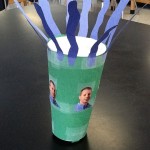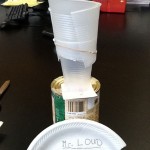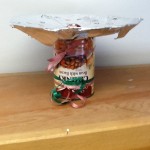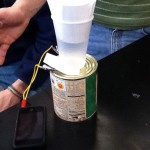We concluded our iPod Speaker Project today, an annual competition in which Regents (Honors/General) Physics students build speakers for their iPods, cell phones, and MP3 players using a neodymium magnet, 30-gauge magnet wire, and whatever pieces and parts they can scrounge together.
The week begins with a brief introduction to waves and sound following the end of our E&M unit. We talk about energy conversions, from stored chemical potential energy in the iPod batteries all the way to electrical impulses in the brain. We also talk very briefly about basic speaker and microphone functionality. At that point, I kick the kids loose to do some research, gather their materials, and start work on a reference design.
Within about 45 minutes of class time, most groups have a working speaker. NOW comes the real work — taking their reference design, evaluating its strengths and weaknesses, and making appropriate design changes and documenting their effects. Students analyze their speaker performance for loudness, clarity, and frequency response, and then modify in an attempt to optimize. Once they’ve gone through a couple iterations, they team up to put together a design report, comparing and contrasting their different designs and attempting to explain why they observed their different responses.
It’s a very open and interesting week, with many groups developing different theories. This becomes the opening discussion for our technical discussion of sound and waves the next week, beginning with misconceptions and working through to basic wave characteristics and phenomena such as reflection and interference. It’s typically a fun week as students start in fear and awe, and work through the “I can’t do it” stage until they finally build confidence and understanding.
Almost as exciting is the final project evaluations. Students evaluate the projects and reports of their peers basic on a pre-determined and publicized scoring rubric. The grading process is always intriguing to watch, as students love to ask questions which I refuse to answer, forcing them to critically evaluate what is being asked, and how the supplied project does or does not meet the criteria. Finally, students are asked to write a single paragraph explaining in their own words how a speaker works, or, alternately, tracing the energy conversions from iPod to brain. This helps me prepare for the following week’s lecture opening, while simultaneously assessing and reinforcing connections made during the week!







